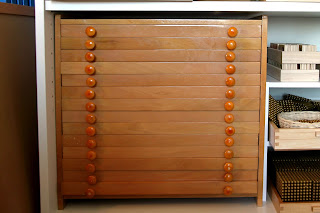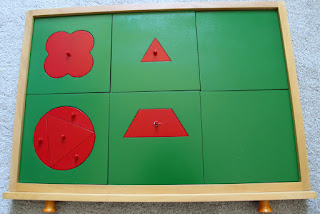If there is one thing I get asked about the most in my school room, it's the large cabinet seen here, displayed on the shelf on the right.
This is the elementary fraction cabinet. It actually contains several different materials in 14 drawers. They are primarily used to explore geometry concepts with Montessori students aged 6-12.
The early understanding of geometry actually begins in the primary period. It is introduced through the sensorial area, although during this plane of development, children are only introduced to the basic nomenclature through materials, such as the Geometric Cabinet. There are a number of materials that extend through the various planes.
I know you would love to see the actual lessons for each material, but I would have to write a ten-part series to cover the various presentation with the depth they deserve. But don't worry, I will have resources for you at the end. My purpose here is to offer a brief overview and simply pique your interest in the beauty of geometry at the elementary level.
The first two drawers includes the Square Fractions, which consists of 9 square fractions. They are broken down into various shapes, including squares and triangles. While this material explores fractions, it also lays the foundation for several key concepts in geometry, including congruence, similarity, and equivalence. The Square Fractions are one of the first materials introduced when exploring geometry, and they are generally introduced to an elementary-age child early in the experience. As simple as this material may seem, it has a vast number of exercises associated with it, and children will often use it extensively.
Here is one way the first drawer would be used to demonstrate principles.
The first set is congruent.
The second set is similar.
The third set is equivalent.
The third drawer contains the Triangle Fractions. This includes four plates of triangles that are divided into various arrangements. They are introduced after the Square Fractions and are used in a similar fashion. They help further develop the concepts of congruence, similarity, and equivalence by showing they hold true for different shapes.
The fourth and fifth drawers contain the Theorem of Pythagoras. It includes two plates, which are used later in lower elementary. The Pythagorean Theorem reveals a special relationship with a right triangle. It states that the square of the hypotenuse is equal to the sum of the squares of the two sides. The plates allow a child to explore this relationship in a concrete manner and even assign numerical values to prove the theorem.
So to put this in layman's terms, the white piece is the right triangle. The red square sits along the hypotenuse. The sum of the yellow and blue squares are equal to the red square. The children can place either the divided triangles or the small squares in the space for the red square to prove it is equivalent.
The sixth drawer contains an extension of the Theorem of Pythagoras called the Euclid Plate. This generally isn't introduced until after a child has worked with the Equivalency Material (discussed next). This is considered an upper elementary work, meaning ages 9-12. I have tried to come up with a concise way to discuss what it represents, so I won't overwhelm you with the detail at this point.
Drawers 7-11 contain the Equivalent Figure Material. It consists of thirteen plates that are used to show equivalent relationships between various figures.
Here is one example of demonstrating equivalency. The pieces from the triangle on the left can be rearranged to form the rectangle on the right. The is generally the first introduction to the Equivalent Figure Material.
There are numerous excises that happen with the various plates. Here is another arrangement. This includes the two decagon plates and two of the rectangle plates. This demonstrates how the decagon is equivalent to half of the rectangle. In the example on the right, the decagon in plate A has been replaced by the pieces in plate D so to show equivalency. You could also demonstrate that plate A is equivalent to half of plate C by putting those pieces into plate A.
The twelfth and thirteenth drawers include the Inscribed And Concentric Figures. These can be used to explore concepts such as: inscribed, circumscribed, concentric, aligned, and tangent. A child can trace the shapes onto paper to show the various relationships.
The fourteenth drawer contains a mix of individual plates. The quatrefoil, small triangle, and trapezoid are often used to further explore geometry concepts in a similar manner to the materials above. They can be traced to show various relationships.
The triangle inscribed circle is used to help develop nomenclature for various parts of a circle.
So there are the contents of the fourteen drawers. I want to point out that I managed to find this material on eBay from a supplier that was closing. It came fully loaded with material, so I certainly don't feel that everything that was included is necessary. I also do not feel that the cabinet is a must have. It just so happened that I was able to get the full set for cheaper than buying the needed materials separately. MBT from What Did We Do All Day has stored their materials in empty geometric cabinets. That is a brilliant solution as well.
I hope I haven't left you feeling overwhelmed. Montessori materials can seem quite mysterious and confusing if you haven't read through the applicable lessons. I can assure you that with the right guidance, you will not only be able to present them, but you will redefine your knowledge of geometry as well. I use Keys of the Universe for all our elementary work, which includes geometry. However, Cultivating Dharma does provide a FREE geometry album, and it's quite good. It's a great way to get a better understanding of how geometry is approached.
Bess
You can find me at Montessori Homeschooling. And don't forget to follow me on Facebook.
This
post is part of the 12 Months of Montessori Series. I am truly honored
to be part of this endeavor. I want to encourage you to visit all the
participating blogs to learn more about Math.




























This absolutely blows my mind, as I know we're headed towards purchasing our own cabinet very soon. May I request your 10 part series? I would love to read and learn all about how to use all of these materials. As we're transitioning from preschool to elementary curriculum this year, I'm feeling so overwhelmed by all I don't know. Thank you so much for this fabulous post!
ReplyDeleteYes! Elementary is such a different beast. I try to take it in tiny chunks. And trust me, you wouldn't want want it in depth from me! The Cultivating Dharma link above does cover quite a bit of it.
DeleteWow! I may actually learn these mathematical concepts, with my child, if I have these hands-on materials. Thanks for sharing the beauty and mystery of elementary Montessori math. :)
ReplyDeleteThank you! And I can't believe how much I'm learning... and I consider myself fairly good at math.
DeleteI never knew these existed! They are sooooo cool! Thanks for sharing the amazing hands-on Montessori materials in the elementary stage!!
ReplyDeleteThank you!
DeleteThis is beautiful, intriguing and I so want to go do it now! :) Awesome post! :)
ReplyDeleteThank you! Montessori is the rabbit hole that keeps going deeper.
DeleteThis is fantastic. It makes me want to go out and buy the cabinet right now. :)
ReplyDeleteThank you!
DeleteWOW! Why isn't math always taught this way!?! Amazing
ReplyDeleteThis is wonderful. I can't wait to learn this way with my kids! Maybe we will all be more confident in fractions.
ReplyDeleteHi Bess! Oh my! Makes me want to have this material ASAP lol. I looooove the activities, for sure my boys will it!
ReplyDelete